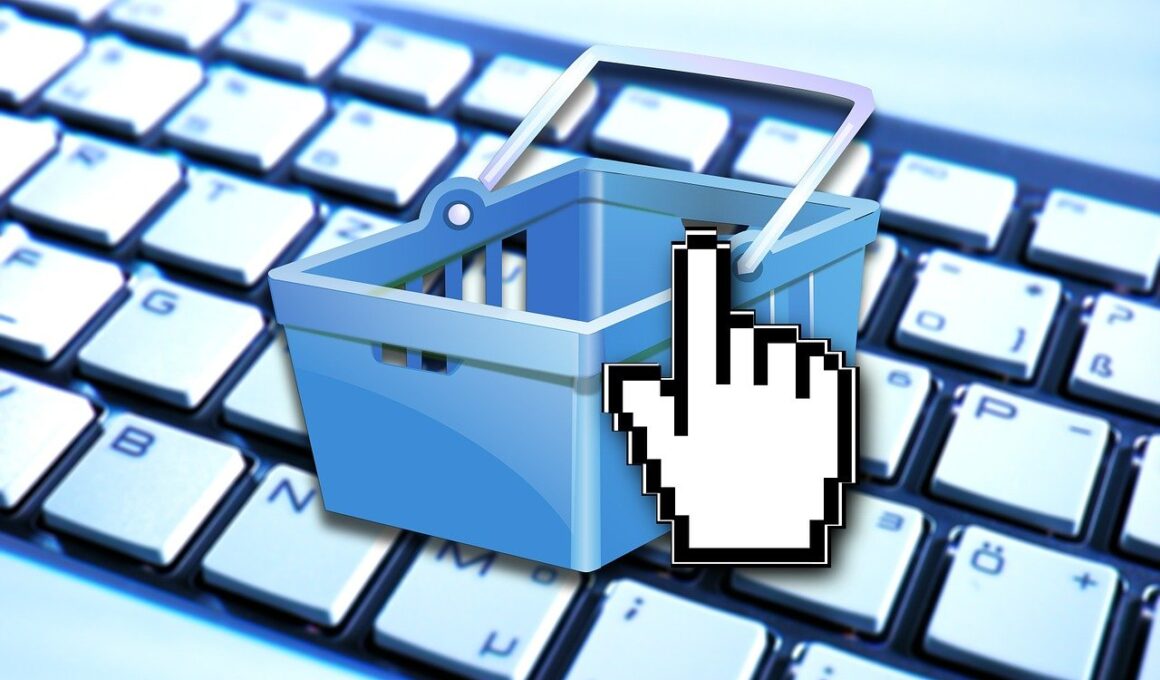Using Data Analytics to Enhance Retail Up-Selling
In today’s competitive retail landscape, leveraging data analytics is crucial for maximizing up-selling opportunities. Retailers can harness customer data to understand their purchasing behavior, preferences, and trends. By analyzing historical sales data, retailers can identify product combinations that are frequently purchased together. This information enables retailers to optimize their product placements and promotions, targeting consumers with products that complement their interests. Data-driven strategies allow businesses to deliver personalized recommendations, ultimately increasing average transaction values. Moreover, predictive analytics can forecast future purchasing behaviors, allowing retailers to strategize their up-selling efforts more effectively. For instance, if data indicates a customer frequently buys coffee, it could be beneficial to suggest complementary coffee accessories or premium products at the point of sale. The key lies in integrating this data into a cohesive marketing strategy that aligns with customer journeys, ensuring messages are relevant and timely. Dealers who adopt comprehensive data analytics strategies can not only enhance customer satisfaction but also drive revenue growth, thus staying ahead in the fast-paced retail environment. Ultimately, success in retail up-selling hinges on a retailer’s ability to analyze and apply data insights effectively.
Another crucial aspect of utilizing data analytics in retail up-selling is segmenting the customer base. Understanding different segments and their unique behaviors allows retailers to tailor their approaches effectively. By employing various data points such as demographics, purchase history, and online behaviors, retailers can create distinct customer segments. For example, young professionals may respond positively to tech gadgets, while families might be more interested in savings on bulk purchases. Retailers can design targeted marketing campaigns that resonate with each segment, including personalized email offers or in-store promotions. This level of personalization not only improves the chances of successful up-selling but also fosters customer loyalty. Additionally, leveraging A/B testing can provide insights into which strategies are more effective within specific segments, thereby allowing continuous improvement. Retailers that invest in analyzing customer segments can create a competitive advantage by offering tailored experiences that meet individual customer needs. Such practices ensure that retailers remain relevant, responding to evolving customer preferences promptly, and enhancing overall satisfaction. Ultimately, segmenting through data analytics forms the foundation of a customer-centric approach to retail marketing.
The Role of Predictive Analytics
Predictive analytics plays a vital role in enhancing retail up-selling by forecasting customer needs and behaviors. By utilizing algorithms that analyze historical data, retailers can anticipate upcoming trends and shifts in consumer preferences. This allows them to proactively suggest products that align with anticipated customer desires rather than just reactive promotions. For instance, if data reveals a seasonal trend of increased demand for certain products, retailers can prepare up-selling strategies that align with this demand. Additionally, predictive analytics can identify customers who are likely to churn or discontinue their shopping behavior. By targeting these customers with tailored offers or incentives, retailers can effectively retain them and stimulate additional purchases. Also, implementing predictive models helps inform inventory decisions, ensuring that complementary products are readily available when customers are likely to buy. This means a seamless shopping experience for consumers, with suggestions appearing in real-time at the point of sale. Through thoughtful application of predictive analytics, retailers significantly enhance their up-selling efforts, making them relevant and timely. In today’s data-driven market, predictive analytics remains an essential tool in every retailer’s strategy for maximizing sales.
Additionally, integrating customer feedback into data analytics can significantly improve up-selling strategies. Retailers often collect feedback from reviews or surveys, which can reveal insights regarding customer satisfaction and product experiences. By analyzing this feedback, retailers can determine which products resonate most with customers and promote them accordingly. Positive feedback on specific items can be utilized in up-sell promotions, creating trust and encouraging more purchases among customers. Furthermore, understanding pain points highlighted in feedback allows retailers to address issues that may hinder up-selling opportunities. For example, if customers frequently express concerns about product compatibility, retailers should ensure that recommendations feature compatible items prominently. This targeted approach aligns marketing efforts with customer sentiments, enhancing their overall shopping experience. By listening to customer feedback and incorporating it into their data-driven strategies, retailers can optimize their product offerings and messaging. Effectively leveraging feedback thus augments analytical insights with real-world consumer voices, enriching the personalization of up-selling techniques. In conclusion, combining customer feedback with data analytics creates a robust strategy for elevating retail up-selling efforts.
Utilizing Artificial Intelligence
The integration of artificial intelligence (AI) into retail data analytics further enhances up-selling techniques. AI technologies can analyze extensive datasets much more swiftly and accurately than human methods, revealing intricate customer insights. For example, AI can identify complex purchasing patterns that may not be obvious, enabling retailers to discover potential up-sell opportunities. Moreover, AI-powered recommendation engines enable retailers to deliver personalized suggestions in real time, thereby amplifying the up-selling process. When a customer adds products to their cart, AI can prompt them with tailored recommendations based on their current selections and past purchasing behavior. This sophisticated level of personalization drives increased conversion rates and customer satisfaction. Furthermore, AI can continuously learn from customer interactions, improving the personalization of suggestions over time. By analyzing customer responses to different up-sell prompts, AI systems can fine-tune their recommendations and optimize their effectiveness. The synergy between data analytics and AI creates powerful tools for retailers looking to maximize revenue. Consequently, AI’s role in leveraging data inspires retailers to innovate and elevate their up-selling strategies to meet evolving consumer expectations.
Additionally, using omnichannel strategies is essential for implementing effective data analytics in retail up-selling. Retailers must ensure a seamless experience across all customer touchpoints, including online and brick-and-mortar stores. By consolidating data from various channels, retailers can develop a comprehensive view of their customers’ interactions and preferences. This omnichannel approach enables businesses to consistently apply their up-selling tactics across multiple channels. For instance, a customer who added items to their online cart can receive personalized up-sell recommendations via mobile notifications. Similarly, in-store associates can engage customers with tailored suggestions while they shop based on their online activity and preferences. This cohesive approach enhances the customer journey, making every interaction an opportunity for up-selling. By aligning all customer experiences, retailers can cultivate stronger relationships and influence purchasing decisions more effectively. Using omnichannel strategies enhances the effectiveness of data analytics in driving up-selling efforts, ensuring customers receive relevant recommendations. As a result, retailers can create a balanced and fulfilling shopping experience that in turn positively impacts overall sales and profitability.
Conclusion: The Future of Retail Up-Selling
In conclusion, the future of retail up-selling lies in the strategic application of data analytics. By harnessing comprehensive customer insights, retailers can personalize marketing initiatives to meet evolving consumer expectations. The methods described, including predictive analytics, customer segmentation, feedback incorporation, and AI integration, combine to create powerful up-selling techniques essential for success. Retailers must continuously adapt and innovate their strategies in line with technological advancements to stay competitive. Emphasizing a data-driven approach enables retailers to discover new up-selling opportunities, effectively increasing customer satisfaction and loyalty. Furthermore, managing and analyzing data proactively positions retailers to respond swiftly to changing market demands and consumer behaviors. Ultimately, retailers that prioritize data analytics in their up-selling strategies will lead the market, shaping the future of retail. Embracing these insights results in thriving businesses prepared for emerging challenges and opportunities. The possibilities for enhancing retail up-selling through data analytics are limitless, and those willing to invest in these tools can reap significant rewards. As we move forward, the synergy between data analytics and retail initiatives promises enhanced customer experiences and increased profitability.
Investing in data analytics for retail up-selling isn’t just a trend but a necessity. As competition increases, retailers must innovate and cultivate meaningful relationships with customers. The strategies mentioned enable retailers to meet this challenge head-on, personalizing the shopping experience intricately and effectively. Retailers who utilize data-driven insights will not only enhance their up-selling potential but also create loyal customer bases that engage with their brand continuously. When customers feel understood and valued, they are more likely to respond positively to up-selling messages and recommendations. Thus, creating an insightful feedback loop can enhance product offerings and improve overall business strategies. In this rapidly changing retail landscape, adaptability is key. Using data analytics helps retailers remain agile and informed, ensuring they evolve with consumer preferences. Moreover, by investing in training and tools, employees can effectively utilize data analytics solutions, ultimately leading to greater employee satisfaction and performance. A culture centered on customer data and insights leads to better decisions at every level. Therefore, educators and leaders must nurture a data-driven mindset in retail organizations, ensuring longevity, success, and continuous improvement in up-selling efforts. All of these factors contribute to an organization that thrives in the retail market.





